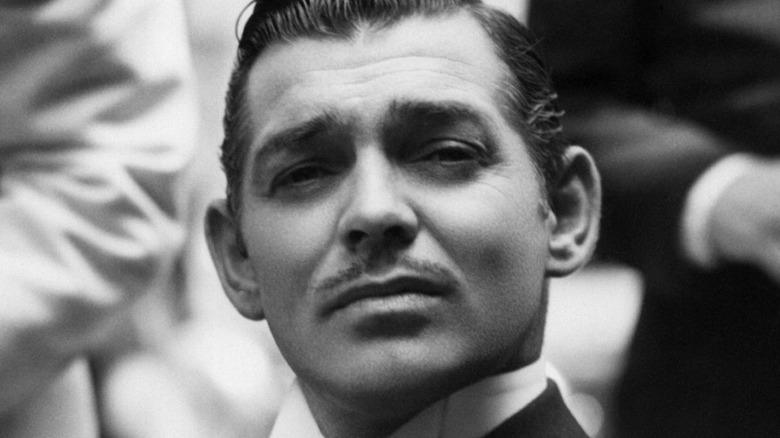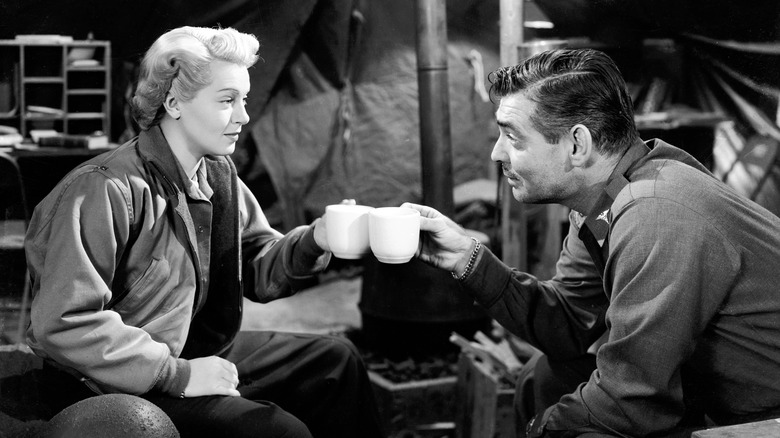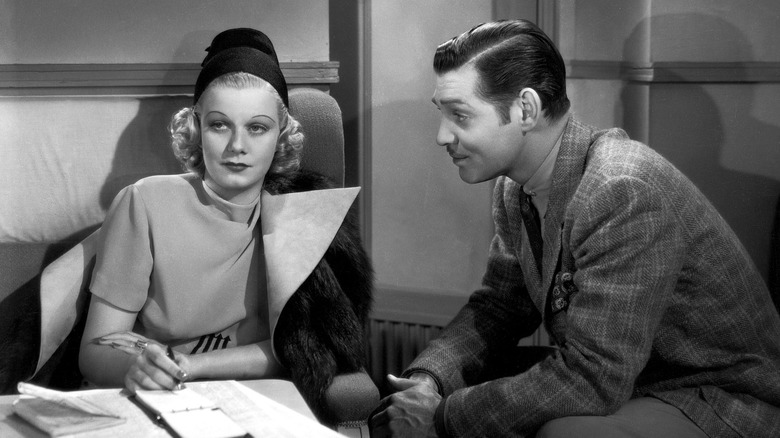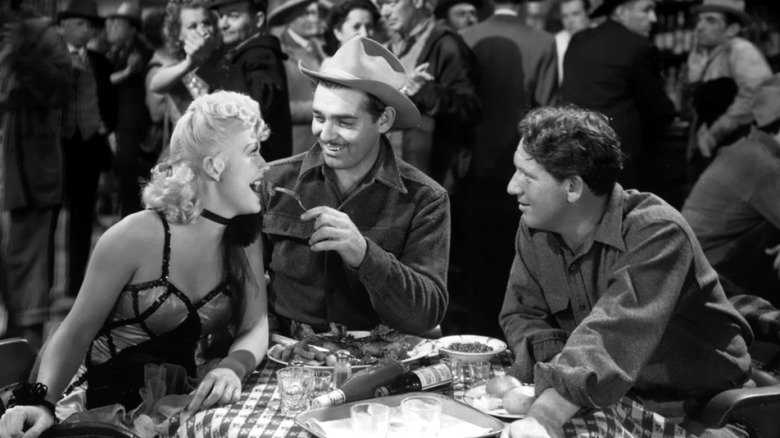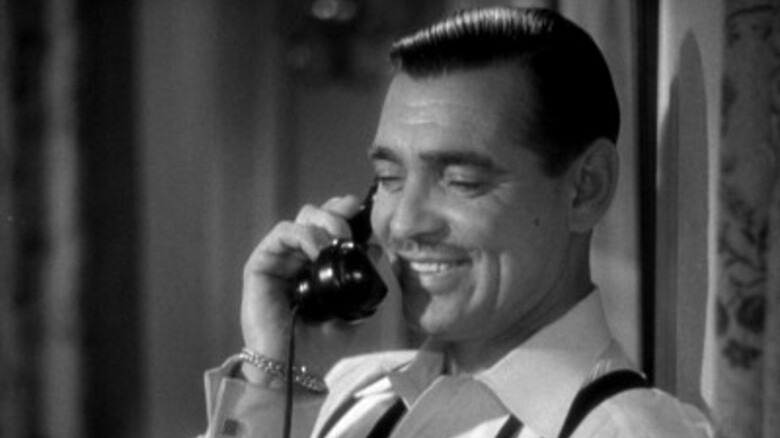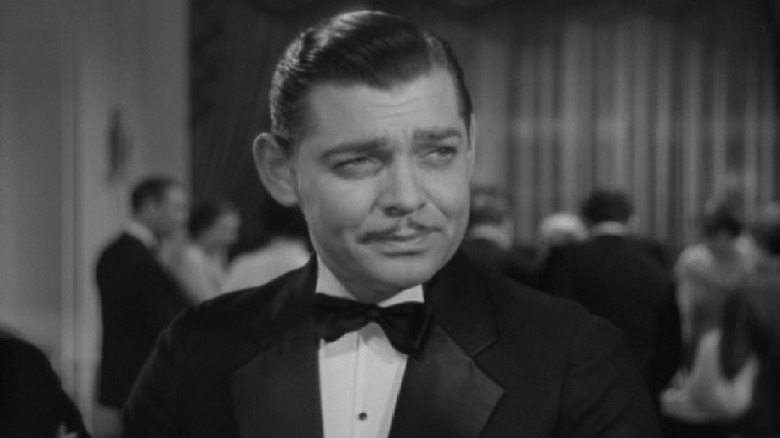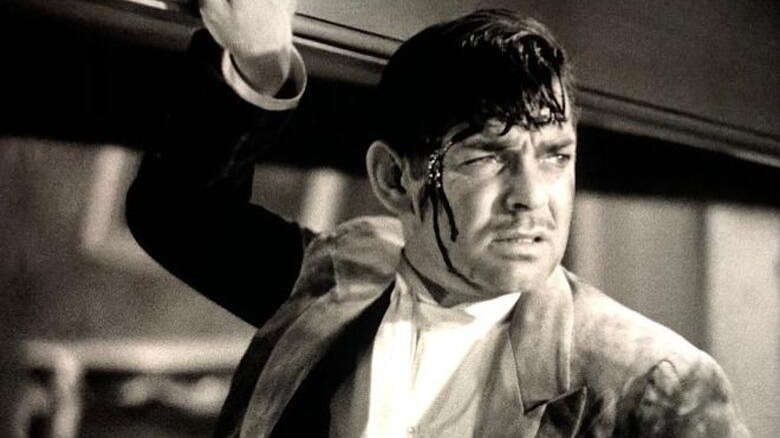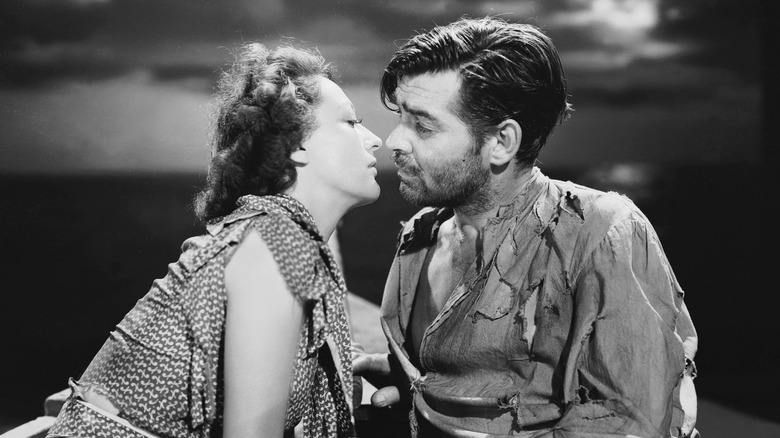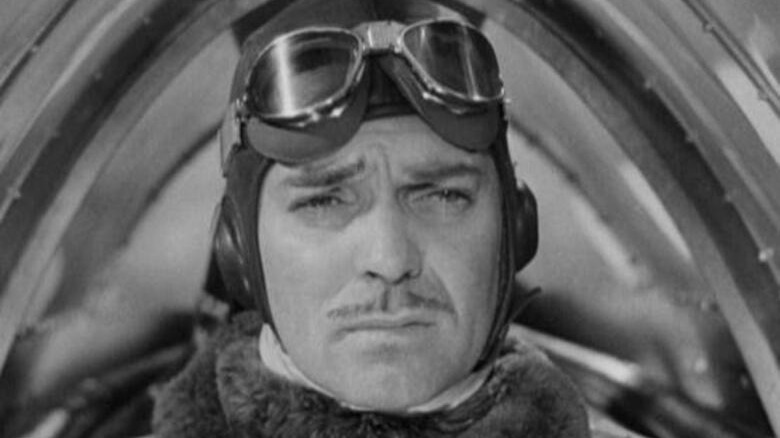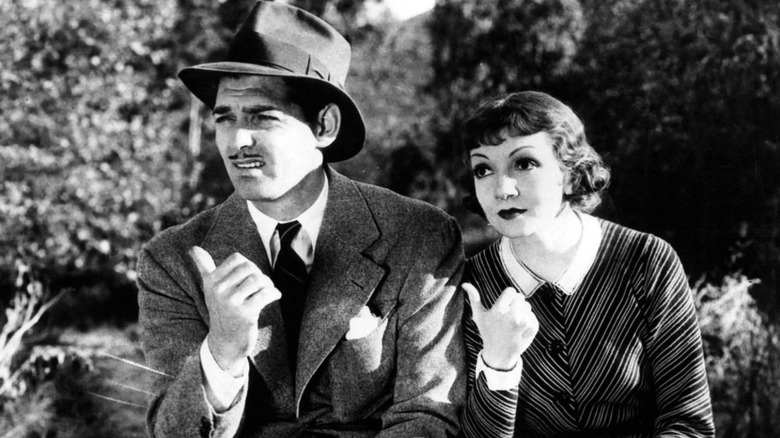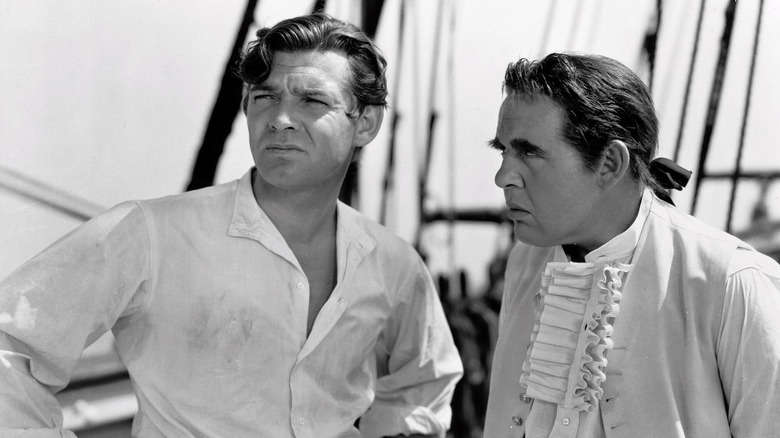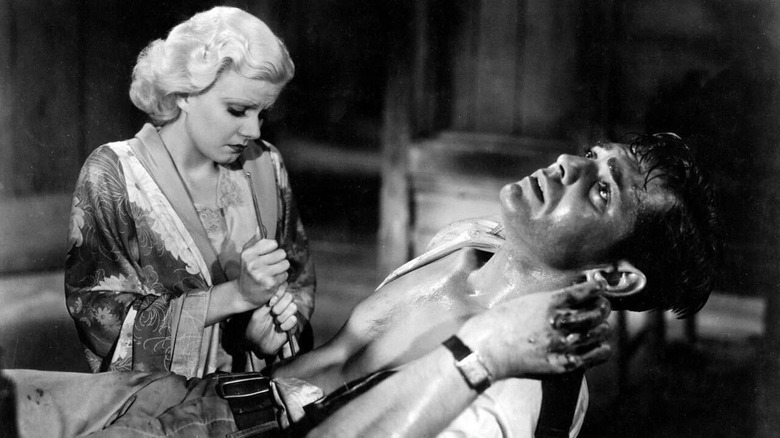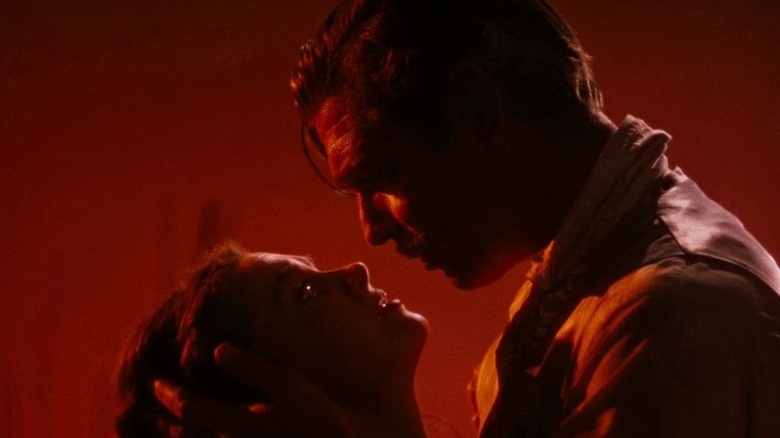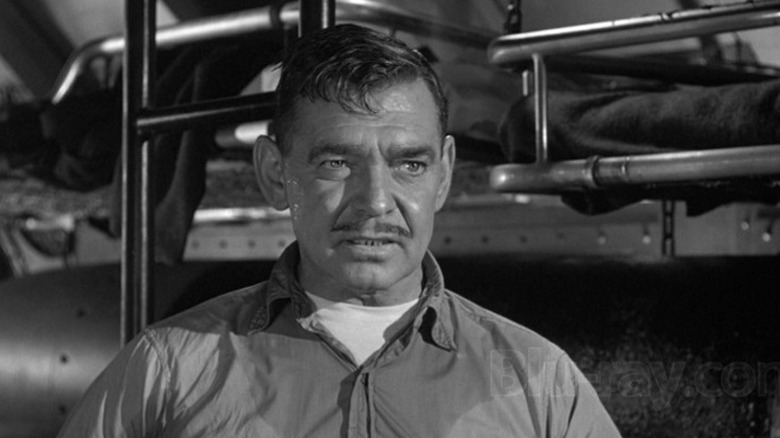The 14 Best Clark Gable Movies, Ranked
One of the biggest names to come out of Hollywood's Golden Age is Clark Gable. The actor starred in several top-earning films, earned three Academy Award nominations for best actor, and won an Oscar for best actor in 1935. At the height of his popularity from the '30s through the '50s, Gable predominantly appeared in romantic comedies and dramas, capitalizing on his raw machismo, good looks, and boyish charisma. More than just a romantic lead, Gable commanded the screen with a presence ranging from charmingly easygoing to fiercely intense.
With an acting career spanning over three decades, Gable not only starred in some of the biggest movies during his heyday but practically defined Hollywood's Golden Age of cinema through his acclaimed performances. Here are the 14 best Clark Gable movies from the award-winning actor's extensive filmography. Let's dive into his most iconic feature film roles and overlooked classics that showcase the admirable range of the actor.
14. Homecoming (1948)
Following his service in the U.S. Army during World War II, Gable's Hollywood return became subtly mirrored in his 1948 film "Homecoming," the third movie he made following his honorable discharge from the military. In "Homecoming," Gable plays Army Colonel Lee Johnson, a surgeon who recounts his WWII experiences to a journalist during his long commute home from Europe. After leaving his estranged wife Penny (Anne Baxter) behind to join the war effort, Lee fell in love with a young Lieutenant nicknamed Snapshot McCall (Lana Turner) while stationed overseas.
"Homecoming" provides Gable with one of his most world-weary performances, playing a man who has endured much professionally and personally from his wartime service. The movie marked the third onscreen collaboration between Turner and Gable and was, by far, their most complex and tragic pairing. After his military service, Gable was well into middle age. The synchronicity between Gable's wartime activities and his character arc adds a poignant foundation for his performance. Gable returned to Hollywood as a mature and changed man, and I think "Homecoming" perfectly exemplifies this transformation, with the actor no longer the cavalier charmer he was.
13. Saratoga
Gable's career as a leading man started by working with reigning Hollywood queen Jean Harlow. After the two memorably lit up the screen in the 1932 film "Red Dust," the two proved they were a natural onscreen couple. The pair reunited in the 1936 movie "Saratoga," which tragically would become Harlow's final film role and was released posthumously. "Saratoga" gives Harlow her onscreen sendoff while Gable would find new depths to play opposite his co-star with considerably more dramatic material to work with than their previous film. Gable isn't playing the virtuous everyman: He's a guy chasing after gambling debts. It's a tricky balancing act to lend sympathy to this character, but Gable pulls it off masterfully.
In "Saratoga," Gable plays Duke Bradley, a horse-race bookie who crosses paths with socialite Carol Clayton (Harlow) after he receives the deed to her family's farm to settle their outstanding gambling debts. Although Duke and Carol are initially involved with other people and face an awkward financial situation, they fall in love. Despite the tragedy surrounding the film's production, with Harlow replaced by physical and vocal stand-ins after her death, the romantic chemistry between her and Gable remains strong, wonderfully closing out their six-film partnership.
12. Boom Town
One of Gable's most effectively recurring co-stars wasn't one of his iconic leading ladies. Instead, it was his longtime friend and colleague Spencer Tracy, with whom Gable appeared in five movies throughout his career. Gable and Tracy's final cinematic pairing is the 1940 film "Boom Town," playing oil wildcatters Big John McMasters and Square John Sand, respectively. As the two men strike it rich, they let their lucrative oil business and shared love for Big John's wife, Betsy Bartlett (Claudette Colbert), derail their personal and professional lives.
Having established onscreen rapport with Tracy and Colbert, Gable plays well off his co-stars. As Big John lets success get to his head, it's believable that this threatens those closest to him. Audiences responded favorably to the chemistry between the three leads in the contemporary Western drama, with "Boom Town" becoming one of the highest-grossing movies in 1940. There is a bittersweet quality to "Boom Town," as the story's fraying friendship mirrors the co-stars' reality. At the time, Fox didn't see Tracy as a leading man. He subsequently secured a contract with MGM, ensuring he would receive top billing in future movies, effectively ending his onscreen run with Gable.
11. The Hucksters
After leaving active military duty in WWII, Gable played against his usual noble on-screen persona in the 1947 film "The Hucksters." Based on the 1946 novel of the same name by Frederic Wakeman, Sr., the movie is a post-war satire about the cutthroat nature of radio advertising. Gable stars as Vic Norman, an advertising executive looking to get back into business after serving in the war while simultaneously romancing two different women.
While Gable's chemistry never quite clicks with his character's primary love interest, played by Deborah Kerr, he crackles whenever he's playing opposite Ava Gardner as Vic's old flame, Jean Ogilvie. Coupled with Gable's satirical performance of frivolous advertisers doing anything to land a contract, "The Hucksters" makes for one of his most offbeat roles — down to Vic literally throwing money away in the movie's opening. While Gable's unscrupulous protagonist may have put off some fans used to his usual work, "The Hucksters" became one of the biggest movies of the year at the box office while showing his growing range as an actor.
10. Manhattan Melodrama
It wasn't often that Gable received the chance to play an outright villain. But his most memorable instance of playing against type was in the 1934 crime film "Manhattan Melodrama." Gable is joined by Myrna Loy and William Powell, with the movie marking their first onscreen pairing in a collaboration that would span 14 films — including the beloved "Thin Man" series. Although Gable received top billing, he played the antagonist and lost his love interest to Powell's Jim Wade.
Gable stars as Blackie Gallagher, who runs an illegal casino in Manhattan. Jim Wade is Blackie's lifelong friend and local district attorney. After Blackie's ex-girlfriend, Eleanor Packer (Loy), leaves him for Jim, Blackie becomes increasingly violent to maintain his illicit business. While the movie's racial messaging, particularly in its portrayal of Harlem, is problematic (to say the least), "Manhattan Melodrama" gives Gable his best antagonistic role. Blackie is a man who has no moral qualms about committing murder for his own self-interests and he does it repeatedly. As someone used to seeing Gable play the good guy, I'm never used to seeing him as a cold-blooded murderer. However, that against-type turn works to the movie's advantage.
9. San Francisco (1936)
Gable and Tracy's on-screen partnership began with 1936's "San Francisco," a musical centered around the San Francisco earthquake of 1906, which leveled a significant portion of the city. Gable plays nightclub owner Blackie Norton who runs for public office under the encouragement of his lifelong friend Father Tim Mullen (Tracy). Blackie plans to reform the city. After Blackie hires singer Mary Blake (Jeannette McDonald) to perform at his club, his friendship with Tim and his professional plans become strained.
While the premise of a new romantic interest completely altering the successful lives of Gable's characters is a common trope throughout his filmography, "San Francisco" has more flash and substance than most of its counterparts. McDonald's musical performances carry the film, and Gable adds dramatic depth with Blackie, as his world erodes before the earthquake strikes. A critical hit, earning six Academy Award nominations, "San Francisco" expanded Gable's acting chops beyond a simple romantic lead while starting his successful pairings with Tracy. Plenty of Gable's characters endured something of a downfall but Blackie gets a rollercoaster of an arc that's more compelling than previous entries on this list.
8. Strange Cargo
One of Gable's most magnetic co-stars is Joan Crawford, appearing opposite him in eight films — taking advantage of the couple's real-life on/off romantic relationship that fired up the tabloids. Gable and Crawford's final onscreen collaboration, 1940's "Strange Cargo," stands as their best work. Gable has a much more dangerous role to play than his usual work. Gable stars as an escaped convict in French Guiana, with Crawford playing a local named Julie who crosses paths with the gruff figure as he hides from the authorities in town.
With "Strange Cargo," Gable and Crawford play significantly more flawed and rounded characters than in previous collaborations. Gable is refreshingly unpredictable in his role as Verne, who is introduced as freshly escaped from prison and threatening Julie with her life. With grittier stakes, "Strange Cargo" is a more grounded role for Gable, omitting the polished veneer that sanitized many characters in the Golden Age of Hollywood. As racy as Gable and Crawford ever got on-screen, "Strange Cargo" proves this working couple saved their best for last, going darker and more lurid than they ever had before.
7. Test Pilot
The middle installment of Gable and Tracy's trilogy of onscreen collaborations, 1938's "Test Pilot," reunited the pair with co-star Myrna Loy for a high-flying romance. Gable stars as boundary-pushing test pilot Jim Lane while Tracy portrays his best friend and faithful mechanic Gunner Morris. Loy stars as Jim's wife, Ann Barton. As Jim and Gunner push the limits of aviation, Jim realizes the toll his occupation is taking on his home life. Ann becomes acutely aware of the risks associated with Jim's career.
What makes "Test Pilot" stand out from Gable's filmography is that there is no romantic rivalry between him and Tracy. Instead, the conflict stems from his sense of self-importance. Jim is a self-centered protagonist who deliberately plays with risks, and it endangers everyone around him. He's not a run-of-the-mill infallible lead. In fact, Gunner's devotion to his best friend not only enables Jim but costs Gunner his life as the price of Jim's hubris. Gunner's death gives Gable one of his most tragic scenes as Jim hits an epiphany too late for his friend. With its thrilling aviation sequences and engaging lead performances, "Test Pilot" was warmly received by audiences and critics alike, earning an Academy Award nomination for Best Picture.
6. It Happened One Night
While Gable starred in numerous romantic comedies throughout his prolific career, none have the same screwball energy as "It Happened One Night," pairing him with Claudette Colbert. Directed by Frank Capra, Colbert stars as spoiled heiress Ellie Andrews who runs away from home and into the arms of disgraced journalist Peter Warne (Gable). Though initially distrustful of each other, the couple falls in love. However, Ellie has to contend with her disapproving father and husband, whom she eloped with impulsively before meeting Peter.
Gable makes for an excellent foil for Colbert, playing well off her energy as Ellie experiences life outside her ivory tower while hiding from her father. He brings a quiet dignity to his role as Peter, delivering a masterfully subtle performance as an unlikely romantic match for Ellie. The movie provides Gable and Colbert with an easygoing entertaining space to play off of each other. The film was an enormous success, winning the Academy Awards for best picture, best director, best actor, and best actress – the sole Oscar win of Gable's lengthy career.
5. Mutiny on the Bounty (1935)
The most engaging adversary Gable ever faced on the big screen was Charles Laughton in the 1935 adaptation of "Mutiny on the Bounty." In the film, Laughton stars as Captain William Bligh and Gable portrays his lieutenant, Fletcher Christian. As Bligh cruelly oversees his Royal Navy crew while sailing across the Pacific Ocean in 1787, Fletcher decides to overthrow Bligh, maroon the tyrannical captain and his loyalists, and seek refuge in Tahiti. There is a noticeable grimness to the proceedings unlike many of the movie's contemporaries. Gable demonstrates a sense of duty and exacting brutality in his multifaceted performance.
Despite the title, Christian's mutiny against Bligh isn't introduced as a foregone conclusion. Gable displays the deep internal conflict in his character leading up to the coup. Christian starts as an officer who dutifully witnesses and endures abuse from his superior before finally reaching his breaking point and coldly calculating his revenge. That slow burn for Christian provides the first half of the movie its mounting suspense: We know Christian is going to break, it's only a matter of when. Laughton and Gable were nominated for the Academy Award for best actor for their roles in "Mutiny in the Bounty," as a testament to how well both actors played off each other with cinematic fury.
4. Red Dust
Although Gable and Harlow appeared in six films together, none had the same raw sexy appeal as 1932's "Red Dust." The film adapted the 1928 stage play of the same name by Wilson Collison. Produced before the industry's Hays Code era, "Red Dust" was much more frank in its handling of sensuality than much of Gable's filmography. There are much more heated romantic scenes between Gable and Harlow which helped catapult Gable to become a leading man.
In "Red Dust," Gable stars as Dennis Carson, who oversees a rubber tree plantation in Vietnam during its colonization by the French and is involved in a casual relationship with local lady of the night, Vantine Jefferson (Harlow). Dennis seduces visiting married woman Barbara Willis (Mary Astor) but changes his mind when he realizes how much Barbara's husband loves her. Providing Gable with a more caddish role than many of his more noble protagonists, "Red Dust" showcases a more complex and nuanced side to his acting chops. The idea of a protagonist committing adultery may have been unheard of in 1932. But Gable finds a way to get the audience to root for the guy — an enormously impressive feat for the period.
3. Gone with the Wind
One of the iconic movies to come out of the Golden Age of Hollywood and Gable's extensive filmography is 1939's "Gone with the Wind," based on the 1936 novel by Margaret Mitchell. A sweeping epic, "Gone with the Wind" tells the tale of Scarlett O'Hara (Vivien Leigh), a Georgia debutante whose privileged life is completely upended by the Civil War and burning of Atlanta. Scarlett falls in love with Confederate blockade runner Rhett Butler (Gable). However, their romance becomes fractured by tragedy and her conflicting love for another man.
With its romanticized view of the antebellum South, "Gone with the Wind" has received its fair share of genuinely deserved critical reevaluation. However, Gable and Leigh's performance remains the lifeblood of the movie. The two bring plenty of passionate intensity to the screen. From his dashing courtship of Scarlett to the searing familial tragedies they endure as a married couple, Gable has more range to play. One particular scene, with Rhett realizing he has accidentally caused a miscarriage, is the single most heartbreaking scene Gable ever put to film and worthy enough to make the movie's inclusion on this list alone. This film showcases just how much raw emotion Gable was capable of capturing. Like the movie, Rhett is a complicated character, and Gable brings to live all those complexities of a man whose family is crumbling around him.
1. Run Silent, Run Deep
With all due respect to "Das Boot" and "U-571," the definitive submarine war movie is 1958's "Run Silent, Run Deep." Directed by Robert Wise, the film adapts the novel of the same name by Edward L. Beach Jr. In "Run Silent, Run Deep," Gable portrays Commander P.J. Richardson. He's determined to get revenge on the Japanese after they sunk his previous ship at the height of WWII. Richardson's executive officer, Jim Bledsoe (Burt Lancaster), becomes troubled by the lengths Richardson schemes, endangering the crew for his fiery vendetta.
Tautly paced and anchored by particularly intense performances from Gable and Lancaster, "Run Silent, Run Deep" is the ultimate submarine thriller that commands the audience's full attention. Gable delivers driven obsession, echoing "Moby Dick," as he focuses on the enemy destroyer responsible for destroying his previous ship and matching wits with its unseen commander. However, Richardson eventually becomes aware of what his vendetta is costing his crew, making for a tragic turn that allows the character to maintain his nobility. Richardson could've been a one-note Ahab analog, but Gable is savvy and experienced enough to bring solid pathos to him. Genuinely thrilling, "Run Silent, Run Deep" holds up decades later and is a perfect showcase for how complex an actor Gable was.
